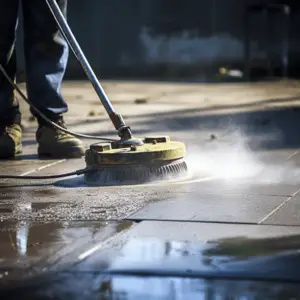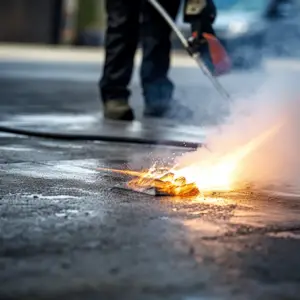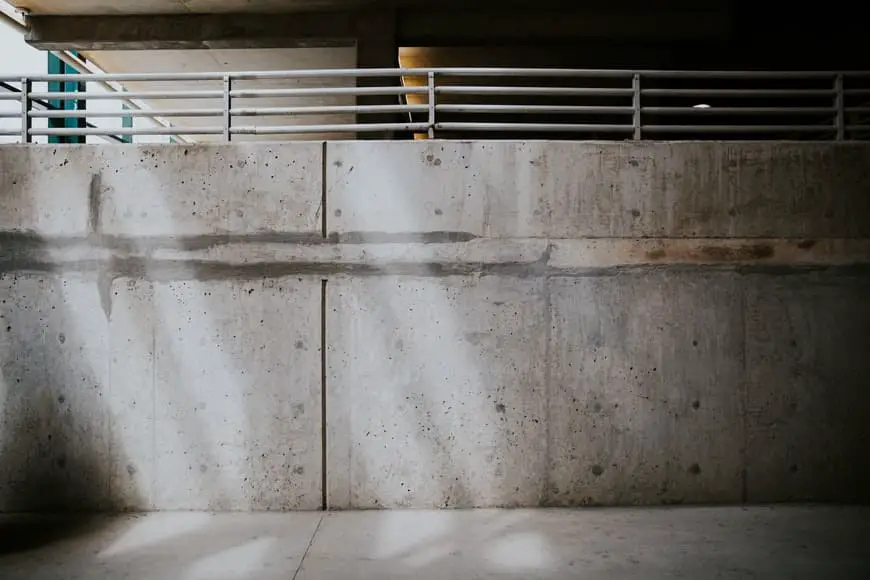Concrete is a fairly absorbent material since it is still porous even when cured. Its ability to absorb mostly water-based solutions or fluids does not mean it cannot absorb petroleum products as well.
In the case of a spill, concrete can get damaged and discolored by long-term exposure to some petroleum products like gasoline.
The longer a concrete surface such as a floor has cured, the harder it is for gasoline to get absorbed into the concrete so the floor will be easier to clean the older it is.
Newer surfaces are more susceptible to absorbing fluids and retaining any effects that those fluids leave behind.
That said, the best principle would be to get rid of the spill as soon as you get the opportunity to wipe it away instead of letting the concrete absorb the fluid and clean a much more stubborn stain later.
Concrete is not all uniform and some forms of concrete are more porous than others. This means that the cleaning method that may work on regular concrete and successfully remove offending odors may not work for blocks with greater porosity or less density.
Dense natural stone can be nearly impervious to absorption but will absorb gasoline if exposure is continual and prolonged.
Gasoline is a pungent and powerful smell and when it is absorbed by your floor, it can be overpowering to be around many times depriving you much needed fresh air causing headaches, nausea, and fatigue.
Table of Contents
How to get gasoline smell out of concrete

Since gasoline is not soluble in water, using water to wash it off is a waste of energy, time, and soap. You will achieve little this way.
How to clean up a gasoline spill
- You must absorb as much gasoline as possible before it sits on the pavement and absorbs, causing a persistent scent.
- Do this using kitty litter. Cat litter absorbs gasoline quickly because it contains corn, wheat, wood, and clay particles. If available, pour on a lot of sawdust to absorb free-flowing gasoline. Avoid flames since this is a fire hazard. This should take an hour.If you can’t find either, use thick towels or heavy textiles that absorb gasoline.
- Lay them all over the spilled gasoline and give them some time to suction the gasoline. A twenty-minute window should suffice. You should be able to determine when you have absorbed the maximum possible amount of gasoline from the spill.
- Collect the items you laid down and burn them. If you used cat litter or sawdust, sweep it up, collect it, and burn it.
- The surface should be dry but you are left with the smell.
- Mix a generous amount of baking soda with vinegar to create a paste with the consistency of frosting. Make enough to completely coat the area that was covered in gasoline.
- The thicker the paste the better it will adhere to the concrete and break apart the gasoline on the concrete so be sure to make as thick a paste as you can.
Gasoline spill
- Spread the paste evenly and thoroughly all over the floor. Do not leave bare spots because untreated surfaces will continue to retain the offensive smell after you have done all this cleaning.
- Leave the mixture overnight or for at least half a day to give it maximum chance to absorb any gasoline that may have seeped into the porous floor underneath. If you rush to clean it you may have to repeat the whole process which is unnecessary.
- The mixture is effective but there is no real way to tell when it is time to clean out the mixture so delay for as long as possible.
- Using a hose or simply a bucket of water and a mop, wash away the mixture.
- You should be able to tell if the smell of gasoline has disappeared with the first few strokes.
- Rinse off the mixture thoroughly with clean water.
- This process is as good as cleaning using soap and water but if you are of the persuasion that you must wash surfaces using soap and water regardless, then by all means go ahead.
- Warm water in this case would be better than cold water to get the scent of soap to soak into the floor.
- In a bucket of warm water, pour a generous amount of pine-scented dish soap. You can also use lemon-scented dish soap.
- Wash the surface thoroughly and before rinsing, let the soapy water sit on the floor for some time. Ten to twenty minutes is more than plenty. Wash it off and revel in your clean freshly scented room once more.
Cleaning concrete that has been exposed to gasoline for too long

Industrial-strength solvents can penetrate concrete and break down gasoline molecules on uncleaned gas station and car repair shop floors.
This is common when buildings are repurposed.
Professionals use toxic chemicals that could hurt you without protection. Luckily, these solvents are restricted and inaccessible to most people.
After numerous gasoline spills, absorbent concrete may not smell clean, but time and washings can.
The best method is patience, thus the process is the same. Sealing concrete prevents it from absorbing anything.


